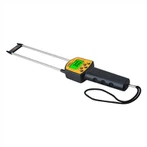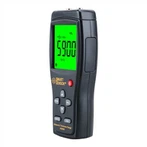The difference between industrial and medical thermometers
A thermometer is a type of thermometer that uses the principle of infrared transmission to sense the surface temperature of an object. It is easy to operate, especially for measuring high-temperature objects. Widely used for measuring surface temperatures of various objects, such as steel casting, furnace temperature, machine parts, glass, and room temperature and body temperature. The infrared thermometer is commonly used.
The infrared thermometer consists of an optical system, a photodetector, a signal amplifier, signal processing, display output, and other components. The optical system concentrates the infrared radiation energy of the target within its field of view, and the size of the field of view is determined by the optical components and their positions of the thermometer. Infrared energy is focused on the photodetector and converted into corresponding electrical signals. The signal is amplified and processed by a signal processing circuit, and then converted into the temperature value of the measured target after being calibrated according to the algorithm and target emissivity inside the instrument.
Whether it is a medical or industrial infrared thermometer, its principle is to receive infrared waves emitted by the human body. The industrial infrared thermometer measures the surface temperature of the human body. The normal temperature of the forehead is about 1-2 ℃ lower than that of the armpit, and the forehead is greatly affected by the environment. Therefore, the armpit temperature is referred to as medical temperature measurement in clinical medicine. Before leaving the factory, the medical thermometer has been modified with software to adjust the difference or limit the relevant range. Industrial products provide more accurate feedback on temperature measurement. The emissivity of a normal human body is 0.98 (default for thermometers is 0.95), so the measured result is around 34-35 ℃. The BG45R product can correct the difference by modifying the emissivity to 0.98 to avoid inaccurate body temperature caused by non professionals using it.






